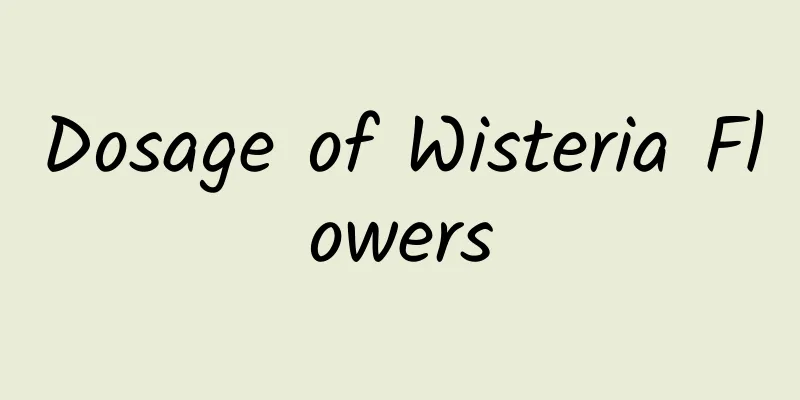Dosage of Wisteria Flowers

|
Wisteria, also known as wisteria, is native to my country. Wisteria is generally planted as an ornamental plant on roadsides, in courtyards, and in parks. Wisteria blooms in early summer. The flowers are purple and bloom in clusters. They are very beautiful. In midsummer, the branches will be full of leaves and pods. Because wisteria flowers have great ornamental effects, they have gradually been introduced to China's neighboring countries, including Japan, South Korea, etc. Chinese people are especially fond of wisteria. No other plant is as widely distributed across the country as wisteria, from Guangzhou in the south to Inner Mongolia in the north. Wisteria flowers are a delicious food ingredient. People usually blanch wisteria flowers and make a cold dish. Wisteria flowers also have certain medicinal value. Beijing's "Purple Wisteria Cake" and some other local "Purple Wisteria Cake", "Purple Wisteria Porridge", "Fried Pueraria Fish", "Cold Pueraria Flowers", "Stir-fried Pueraria Flowers", etc. are all made with Wisteria flowers. Wisteria flowers can be used to extract aromatic oils, which have the effects of detoxification, anti-vomiting and diarrhea. Wisteria seeds are slightly poisonous and contain cyanide. They can cure muscle and bone pain and prevent wine from spoiling. Wisteria bark has the effects of killing insects, relieving pain, dispelling wind and unblocking meridians, and can treat tendon and bone pain, rheumatism, pinworm disease, etc. [Abdominal swelling] Take appropriate amount of Wisteria flowers, add water and boil them into a thick juice, remove the residue and add sugar to make a paste, take one spoon each time, drink with boiled water, twice a day. [Gastric Cancer] 1-6 grams of Wisteria tumor (if there is no tumor, use the vine stem and leaves), equal amounts of Wisteria sinensis seeds, wild water chestnuts, and Terminalia chebula seeds, decocted in water, and taken twice a day. [Anti-corrosion] Fry the seeds and grind them into powder, then add them into wine. 1. To get rid of burnworms: 10-15g of root, decocted in water. 2. Weak constitution: 30g root, stewed with pork. 3. Pain caused by wind-heat: decoct 15g each of Wisteria sinensis root and Caragana odorifera root in water and drink. 4. Pain in muscles and bones: fry 50 grams of Wisteria seeds and soak them in one pound of shochu. Take 25 grams each time, once in the morning and once in the evening. Wisteria belongs to the leguminous family. When it blooms, the inflorescence can be as long as 20 to 30 centimeters. Each inflorescence has fifty to one hundred flowers and has a fragrant smell. If wisteria is well cultivated and managed, it can bloom again in late summer and early autumn. Wisteria flowers are both medicinal and edible. When used as medicine, there is no need to worry about the dosage of wisteria flowers. |
Recommend
From 28 hours to 8 hours, why is the speed of "returning home from space" getting faster and faster? How many launches will there be for the construction of the space station in 2022?
On April 16, the return capsule of the Shenzhou 1...
Is it good for women to drink American ginseng?
American ginseng, also known as American ginseng,...
The efficacy and function of the white gun
The white gun barrel has a long history, and unti...
The efficacy and function of King Kong vine
There are so many medicinal herbs in the world, a...
Effects of Nine Dead Resurrection Grass
When hearing this name for the first time, I beli...
Are there any side effects of long-term drinking of Codonopsis?
Life is a kind of life that has excellent effects...
What are the effects and functions of snake shedding
We all know about snake slough, which is the skin...
The efficacy and function of the root of hairy mulberry
There are many common Chinese medicinal materials...
How to eat Lingzhi slices?
Everyone knows that the medicinal value of Lingzh...
What are the functions, effects and edible methods of Perilla seeds?
Perilla seed, also known as Perilla frutescens, i...
The efficacy and function of Thousand Layer Tower
Traditional Chinese medicine is very helpful in t...
The efficacy and function of Psoralea corylifolia
Psoralea corylifolia is also known as Psoralea co...
The role and efficacy of Eucommia ulmoides
From ancient times to the present, Eucommia ulmoi...
The efficacy and function of Ruiliancao
Many people are not very clear about the effects ...
International Left-Handers Day | Are left-handed people really smarter?
August 13 is International Left-Handers Day, and ...









